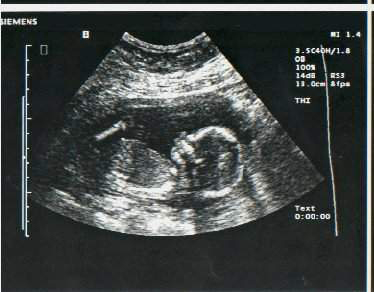
Superhuman Moms With Average Babies: The Cyborgization of Prenatal CareJessica Kriet Reproduction can be considered one of the most natural and highly regarded of life's processes. Pregnant women are given specific treatment throughout gestation, such as supplemental vitamins and frequent checkups. Although this supplemental care continues, Anne Balsamo, in her book Technologies of the Gendered Body, argues that with today's prenatal diagnostic technologies, the fetus is rapidly becoming the primary patient (90). Technologies such as ultrasounds and amniocentesis allow parents to connect with and monitor babies before birth., "The family communicates with the child, at least partially, through a machine, " (Gray 1, 92). By utilizing this technology, mothers and their unborn children alike are becoming cyborgs by definition. However, mothers, "…have the right to not choose [these technologies]. But it will become increasingly awkward for them to exercise this option. And perhaps someday it will even be considered cruel and unethical, " (Dvorsky). An ultrasound is one of the most common and well-known methods of prenatal care for modern mothers. The technology for this procedure was developed as a RADAR underwater equivalent system during WWII. The most common method involves coating the mother's stomach with a jelly and then rubbing the device around the area where the baby is. The reflected image is then translated onto a monitor, where gender and/or abnormalities become visible and can be noted by a doctor (Gray 2, 187). This technological window to the womb lets the doctor decide if further testing and observation of the unborn fetus is necessary, while giving the mother the first opportunity to visually bond with her future son or daughter. As Gray writes in The Cyborg Handbook,, "…these visual fetal cyborgs replace the organic fetal beings still inside their mother's bodies in another part of the hospital or at home. The representation becomes the phenomenon, " (187). 
This image shows approximately what a standard ultrasound will display. From an image such as this, a doctor can observe noticeable abnormalities and often determine gender. People in today's consumer culture have latched on to this desire to use technology to bond with their future children as early as possible. A studio called A Peek in the Pod in the Upper East Side of New York City uses a more sophisticated ultrasound machine to give mothers, "color, " photos of their fetuses. However, medical professionals are exceptionally wary of these practices. The three main concerns are that mothers may either incorrectly perceive that something is wrong, incorrectly assume everything is fine, and/or that the ultrasound may potentially cause harm with the additional, non-medical exposure. An incorrect analysis can prove harmful to the child in the future by not having the mother receive the care they need while pregnant (Penny). This story outlines the studio's procedures and reactions from both sides. Some centers have begun to use ultrasounds to sway unsure mothers from terminating their unborn child. By showing them images of their baby-to-be, women have a human face to connect with. These clinics do offer valid information, but usually their focus is to prevent abortions, and therefore are not ideal places for all pregnant women. Some pro-choice advocates express concerns about these centers appealing to emotions rather than delivering unbiased medical care (Gibbs). This sentimental reaction has also been displayed in popular culture. In a Star Trek: The Next Generation episode, counselor Deanna Troi is mysteriously impregnated by an unknown being. As the commanders of the ship begin to panic and debate on whether or not to abort the child, Troi watches the fetus moving on the monitor, and the sound of a heartbeat resonates. She begins to touch her stomach protectively, and defiantly declares that she is going to have her baby, no matter what they feel they must do to protect the rest of the ship and the crew. Even though this future might have the potential to nourish a child outside a human womb, the power of visual connection is enough to make her potentially endanger herself and the ship (, "The Child, "). In general, ultrasounds can be considered safe when properly performed for gathering of possibly necessary information. However, some studies show that excessive exposure possibly results in a decrease in newborn body weight, a higher chance of left-handedness, and an increased probability of delayed speech (Volkin). Amniocentesis can follow an abnormal ultrasound observation. It is recommended in general for women with higher risks of having a baby with a genetic abnormality/disorder. Women at higher risk include women over age 35 and those potentially carrying recessive genetic disorders (Haratz-Rubinstein). Similar to amniocentesis but less invasive, and slightly less potentially harmful is chorionic villus sampling, or CVS. This procedure involves a doctor using a catheter to go through a woman's cervix to the outermost fetal membrane, where he or she will use a syringe to remove villi (tiny, hair-like appendages) from the membrane. Once removed, they can separate the fetal genes from the mother's genes for analysis (Gray 2, 188). CVS is typically performed earlier in pregnancy, usually between 11 to 12 weeks, which can possibly allow a woman to terminate the pregnancy during the first trimester. 
This image shows a basic breakdown of what an amniotic fluid retrieval for analysis would entail. Amniocentesis is typically performed when a woman is 16 to 20 weeks pregnant. This procedure involves an ultrasound scan to determine the baby's general anatomy as well as to determine his or her position in the womb. With this continuous picture, the doctor will insert a needle through the abdominal wall into the amniotic sac, where he or she will withdraw a sample of amniotic fluid for analysis. The full results should be available to mothers within two weeks. Click here for a more in-depth explanation of the overall procedure. The main benefit and purpose of this procedure is to alert parents to any possible severe abnormalities in their children. With this knowledge, they can either prepare for any special care their child will need or possibly choose to terminate the pregnancy. The main physical problem with this technology is the increased risk of miscarriage. The rate of miscarriage is approximately one in 400. Emotionally, knowing their baby has potential for disorder can cause the parents a great deal of stress, especially without definite knowledge of chances or of the disorder (Haratz-Rubinstein). Armed with this knowledge, or even a gender bias, eugenic abortion is becoming commonplace. It is estimated that fetuses diagnosed with Downs Syndrome through these methods are aborted roughly 80 percent of the time. Up to 95 percent of parents terminate pregnancies with a positive test for cystic fibrosis. Definite statistics are nearly impossible to find in determining sex-selection abortions (Neumayr). Another trend currently occurring involves men as the producers of babies with mother acting solely as a vessel, a living heart/lung machine for the infant. Using methods such as in vitro fertilization, aforementioned technologies, and being in charge of the delivery of the baby, men can control when the baby is made, determine its health, and become the first to physically hold their new child (Davis-Floyd, 4-6). In the future, the potential for genetic engineering could allow parents to select traits for their children before conception and ensure their genetic material would be disorder-free. Artificial external wombs are already being developed. A functional mouse womb may be possible within the next five years, and a functional human womb within the next 10, assuming fetal testing restrictions are eased (Reynolds). While this may sound beyond our capabilities, the story behind this technology can be found here. Whether or not most modern mothers realize it, what is considered routine prenatal care is a routine cyborgization. Either by a desire for aide from the finest technology or from fear of being accused of negligence on behalf of the baby, parents are driven to these procedures, yet still cringe at the term, "cyborg, ". Being enhanced by technology, especially temporarily, does not make us less of who we are. I agree with George Dvorsky in asking, "Why should we not push the envelope of where intelligent life can take itself? Isn't this the very essence of what it means to be human?, " In actuality, utilizing these technologies makes us more human by enforcing the natural instinct of caring for our young. Becoming cyborgs is simply the next step in our evolution. Bibliography
Balsamo, Anne. Technologies of the Gendered Body: Reading Cyborg Women. Durham: Duke University Press, 1996. |










